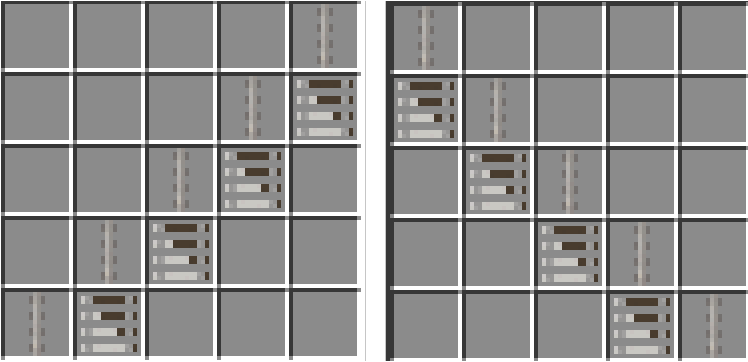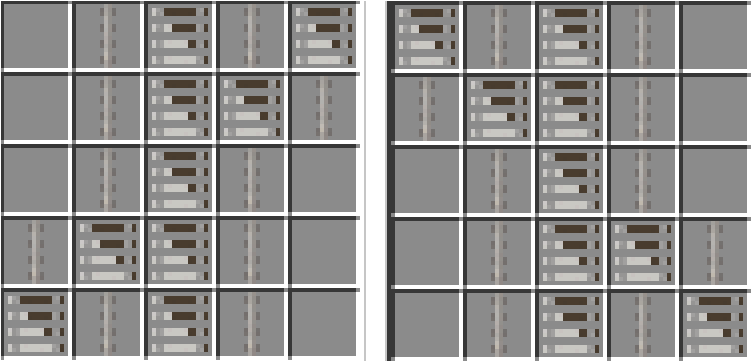Zora no Densha
Welcome to the Zora no Densha Wiki page! We hope you will enjoy your stay and find what you are looking for.
- Home
- ZnD Releases
- Crafting & placing Tracks
- Driving, placing & creating Trains
- Magnets, Paths & Signals
- Signalpacks
- Items, Fluids, etc.
Home
CLICK HERE TO GO TO THE CHAPTER OVERVIEW!
CUSTOM MODELS CAN BE FOUND HERE!
About Zora no Densha
Zora no Densha is a modification for Minecraft that brings tracks, rail vehicles, and a lot of other railway-related features into the game. The initial idea is based off a private server project for which no suitable railway-themed modification could be found, ultimately leading to the creation of Zora no Densha.
Today, Zora no Densha brings realistic trains with high detail and great customisability into your Minecraft worlds. We are striving to increase simplicity while maintaining complexity, so everyone can enjoy a realistic mod without having to worry about too much complication. That's what we are working on - today, tomorrow, and in years to come.
Quick Information:
Tracks
Zora no Densha adds a number of different track types.
Find out about these tracks right here.
Train Controls
A list of all default train controls in Zora no Densha can be found here.
You can change the controls inside the mod's configuration menu. It is accessible via Minecraft's title screen.
Blocks and Items
See which Blocks, Fluids, and Items Zora no Densha brings into Minecraft, and view their crafting recipes.
Custom Models
If you feel creative, you can assemble your own custom trains in the Model Editor. This tutorial explains how the Model Editor works.
After you finished your model, feel free to upload it to our train-yard.
Note: You need to have an account to be able to upload your creation. Click here to sign up.
Tutorials
Installation and Configuration
A guide to help you install and configure Zora no Densha. There is also an explanation of how to change keyboard key bindings.
First Steps with Tracks and Trains
Find out how to build tracks here. Once you have some infrastructure ready, learn how to place trains right here.
Driving Trains
Since it's a bit much to read, we split the tutorial on how to use your trains into three categories:
- a quick tutorial explaining how to actually drive trains;
- an extended tutorial explaining some advanced features of trains;
- and a short explanation of how trains are coupled together.
Implementing Custom Vehicle Parts
If you enjoy creating things with the Model Editor or maybe just wish to see your favourite train inside of Minecraft, there's a tutorial on how to implement custom parts.
ZnD Releases
You can Download the newest ZnD versions here.
Stable Releases
Here you can download Stable Releases of the base mod. You can also see what has been changed in the Version History below.
Version History:
Version 0.9.0.2-HOTFIX:
- Latest Stable release
- Removed various items due to instability/for future rework
- Fixed and polished everything
- A detailed changelog can be found here
Beta Releases
Here you can download Beta Releases of the base mod. You can also see what has been changed in the Version History below.
Version History:
Version 0.10.1-snapshot 11:
- Fixes and changes to the fullscreen modeler
Version 0.10.1-snapshot 9:
Featureupdates:
- Replaced the small model editor with the fullscreen model editor
Bugfixes:
- Fixed a bug, which made the game unresponsive, whenever a model with the container part and an image on that was loaded
- Fixed a bug, which caused the game to crash, when one printed a preset
Version 0.10.1-snapshot 7 (mostly stable):
Featureupdates:
- Added Signalpack support
Bugfixes:
- Fixed trains colliding with other trains when going around corners (not world yet)
- Fixed train hitboxes
- Fixed bugged speed sign icons
- Some changes to signalling to ensure two trains can't crash head-on in bidirectional areas
Version 0.8-snapshot Nov2015:
- This version is way too old to tell you what has been fixed and what not
- To my experience it is actually somewhat stable, but probably only use it to "enrich" the Stable release
- Works with Stable Version 0.9.0.2 HOTFIX
Crafting & placing Tracks
Crafting Tracks
Tracks are built in several steps and require varying numbers and types of items, depending on the track you're trying to build. Here's the process of creating your railways, split into a number of steps:
1. Getting the Blueprint
Open the Engineer's Table GUI and switch to the first tab, if you aren't already there. The tracks tab is the left-most tab, the one with the rail.
Use the items on the right to place the track recipe into the 5x5 grid on the left. Then, put paper and ink into the two slots below the 5x5 grid. If your shape is valid, it'll print the track's blueprint. The printing process is indicated by the triangular shape going white. Once finished, you can take the blueprint out from the large slot in the center.
All track blueprints can also be found in the Zora no Densha General Creative Tab.
2. Placing the guides
With your blueprint in hand, point at the block you'd like to place the track on. If the track can be placed (i.e. if there are no obstructions, and the ground is even), a transparent, blue ghost-track will appear. Right-click to confirm and to place the guides. If successful, the track's hitboxes will appear, along with red-white stilts marking the track's path.
While the track shows guides, it is safe to dig and remove the ground below. Removing ground from below (partially) finished tracks will destroy them.
If you misplace a blueprint, you can break it by hand if it's empty. If you want to take away a component, you'll have to break it with a crowbar.
3. Finishing the track
Gather and apply all items of the track. As rule of thumb, each track needs as many Track Beds, Clamps, and Rails as it is meters long. I.e. a straight track of 8 meters length will need 8 Track Beds, Clamps, and Rails. Special tracks might require additional items. Some tracks can also receive an upgrade with Crossing Plates.
Apply track parts in following order:
- Track beds first
- clamps follow
- rails finish.
Crossing plates and any additional items come last.
Note that an exception is the maintenance track; it requires Stilts instead of Track Beds.
Demolishing
To remove a track while retaining its items, hit the track with a Crowbar. Any other item will break the track.
Extra: Copying tracks while in creative mode
Using the Trackman's Tool, it is possible to copy finished tracks.
Right-click the track you'd like to copy. A chat message should appear to confirm that the track was successfully copied. You can now create infinite copies of the track.
Note: As tracks are a Tile Entity, it is generally unsafe to copy them using WorldEdit or similar tools. We do not take responsibility in case of crashes or any other unexpected behaviour that resulted from track copying.
Types of Tracks
Straights:
Straight Track (0°)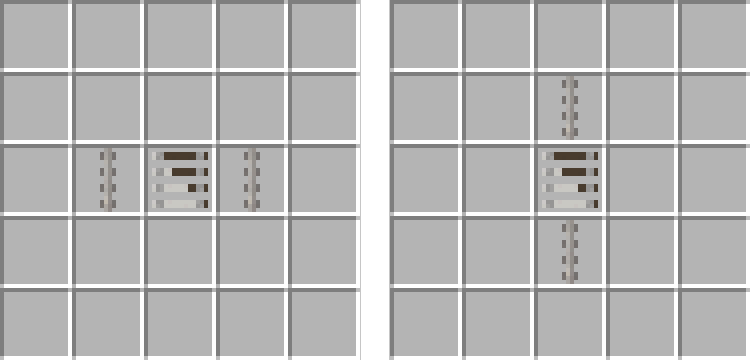
- Area: 1x1
- Track Beds: 1
- Fastenings: 1
- Rails: 1
- Plates: 1
Straight Track (0°,2m)
- Area: 1x2
- Track Beds: 2
- Fastenings: 2
- Rails: 2
- Plates: 2
Straight Track (0°, 4m)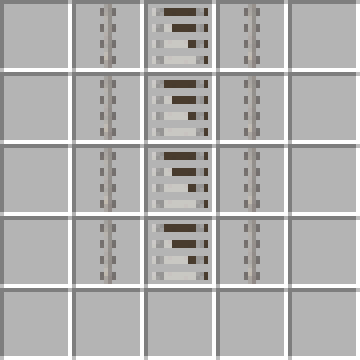
- Area: 1x4
- Track Beds: 4
- Fastenings: 4
- Rails: 4
- Plates: 4
Straight Track (0°, 8m)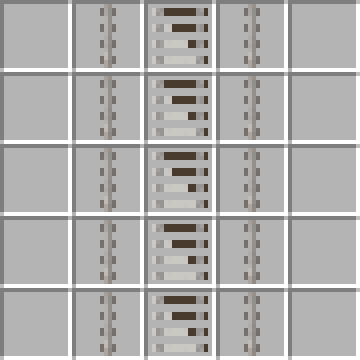
- Area: 1x8
- Track Beds: 8
- Fastenings: 8
- Rails: 8
- Plates: 8
Straight Maintenance Track (0°)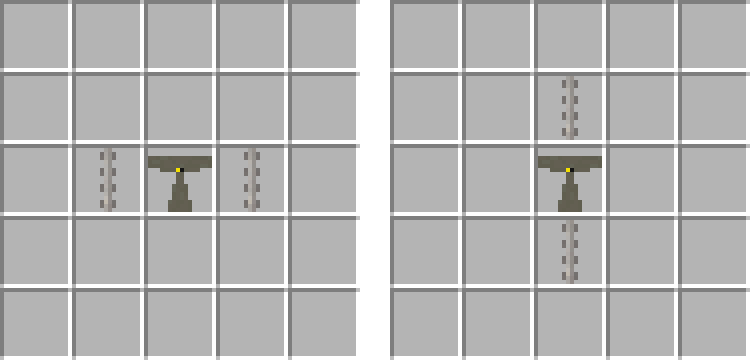
- Area: 1x1
- Stilts: 1
- Fastenings: 1
- Rails: 1
Straight Track (11°)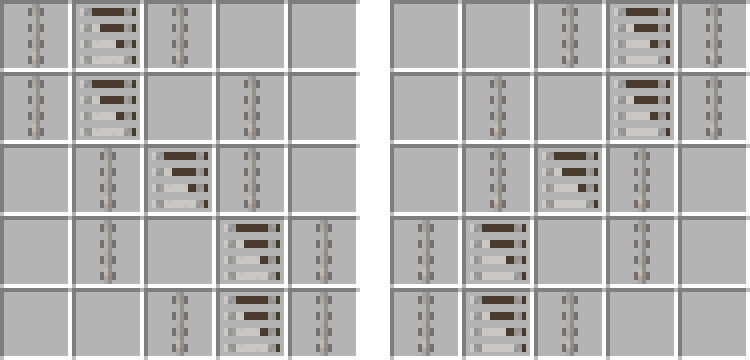
- Area: 2x5
- Track Beds: 5
- Fastenings: 5
- Rails: 5
- Plates: 5
Straight Track (18°)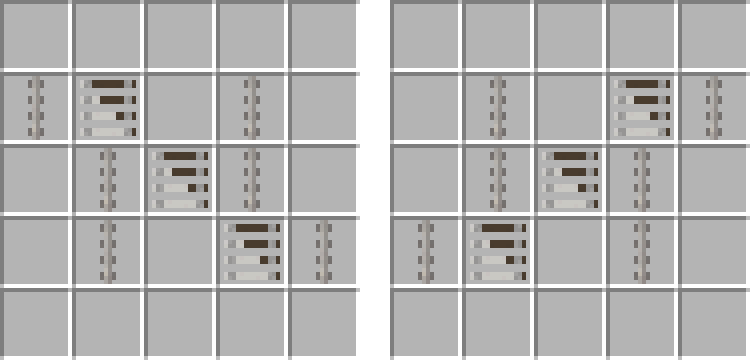
- Area: 2x3
- Track Beds: 3
- Fastenings: 3
- Rails: 3
- Plates: 3
Straight Track (45°)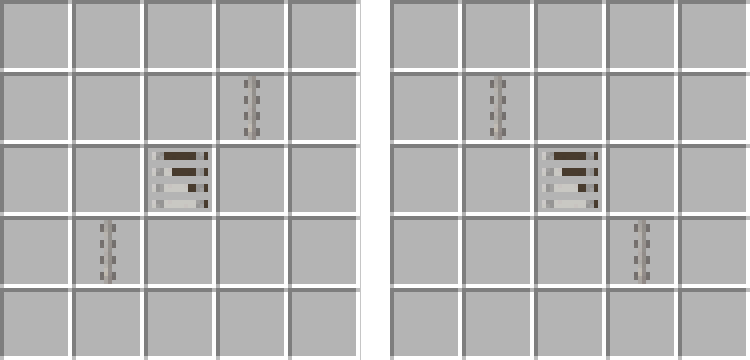
- Area: 1x1 (Overhanging)
- Track Beds: 1
- Fastenings: 1
- Rails: 1
- Plates: 1
Straight Track (45°,2m)
- Area: 1x2 (Overhanging)
- Track Beds: 2
- Fastenings: 2
- Rails: 2
- Plates: 2
Straight Track (45°,4m)
- Area: 1x4 (Overhanging)
- Track Beds: 4
- Fastenings: 4
- Rails: 4
- Plates: 4
Straight Track (45°,8m)
- Area: 1x8 (Overhanging)
- Track Beds: 8
- Fastenings: 8
- Rails: 8
- Plates: 8
Slope Track (10m)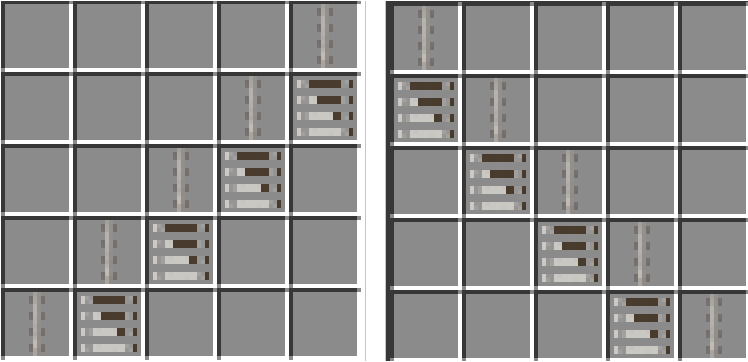
- Area: 1x10
- Track Beds: 10
- Fastenings: 10
- Rails: 10
Slope Track (16m)
- Area: 1x16
- Track Beds: 16
- Fastenings: 16
- Rails: 16
Curves:
Curve Track (0° to 11°)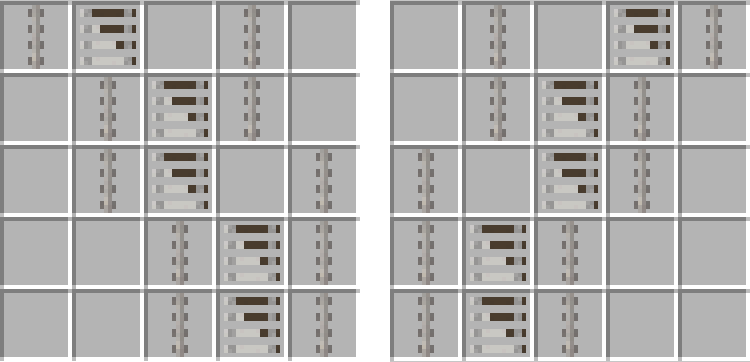
- Area: 2x10
- Track Beds: 10
- Fastenings: 10
- Rails: 10
Curve Track (11° to 18°)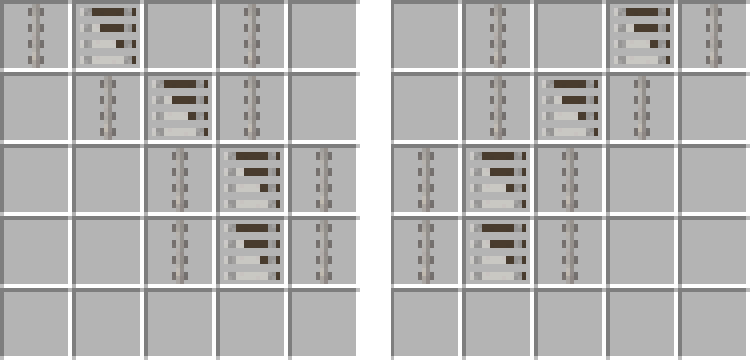
- Area: 2x4
- Track Beds: 4
- Fastenings: 4
- Rails: 4
Curve Track (18° to 45°,6m)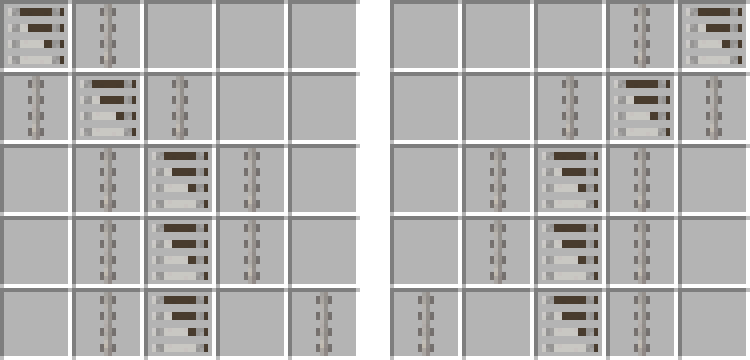
- Area: 4x6
- Track Beds: 6
- Fastenings: 6
- Rails: 6
Curve Track (18° to 45°,10m)
- Area: 4x10
- Track Beds: 10
- Fastenings: 10
- Rails: 10
S-Curve Track (0°, 8m)
- Area: 2x8
- Track Beds: 8
- Fastenings: 8
- Rails: 8
Switches:
Switch Track (0° to 0°/11°)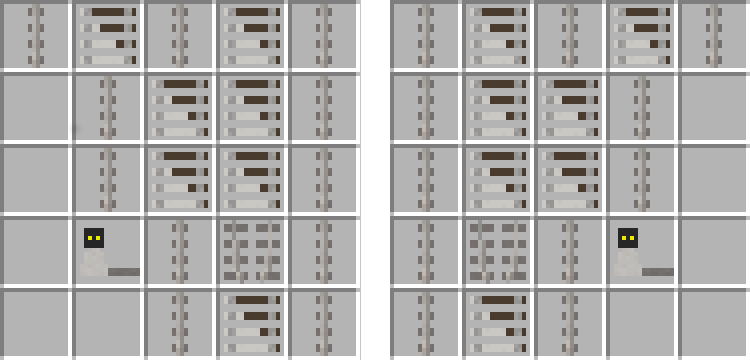
- Area: 2x10
- Track Beds: 7
- Fastenings: 11
- Rails: 11
Switch Track (11° to 11°/0°)
- Area: 2x10
- Track Beds: 7
- Fastenings: 11
- Rails: 11
Crossings:
Cross Track (0°)
- Area: 1x1
- Track Beds: 1
- Fastenings: 1
- Rails: 1
 Cross Track (0°/11°)
Cross Track (0°/11°)
- Area: 1x10
- Track Beds: 11
- Fastenings: 11
- Rails: 11
Cross Track (11°/11°,10m)
- Area: 1x10
- Track Beds: 11
- Fastenings: 11
- Rails: 11
Cross Track (11°/11°,5m)
- Area: 1x5
- Track Beds: 6
- Fastenings: 6
- Rails: 6
Cross Track (45°)
- Area: 1x1
- Track Beds: 1
- Fastenings: 1
- Rails: 1
Others:
Buffer Track (0°)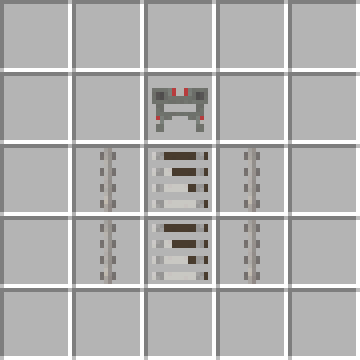
- Area: 1x2
- Track Beds: 2
- Fastenings: 2
- Rails: 2
- Plates: 1
- Buffer: 1
Buffer Track (11°)
- Area: 1x2
- Track Beds: 2
- Fastenings: 2
- Rails: 2
- Plates: 1
- Buffer: 1
Buffer Track (18°)
- Area: 1x2
- Track Beds: 2
- Fastenings: 2
- Rails: 2
- Plates: 1
- Buffer: 1
Buffer Track (45°)
- Area: 1x2
- Track Beds: 2
- Fastenings: 2
- Rails: 2
- Plates: 1
- Buffer: 1
Transition Track (0°)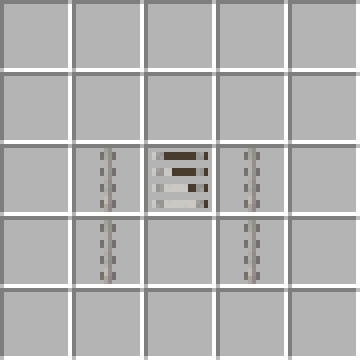
- Area: 1x2
- Track Beds: 2
- Fastenings: 2
- Rails: 2
Further Information
Maintenance Track (0°)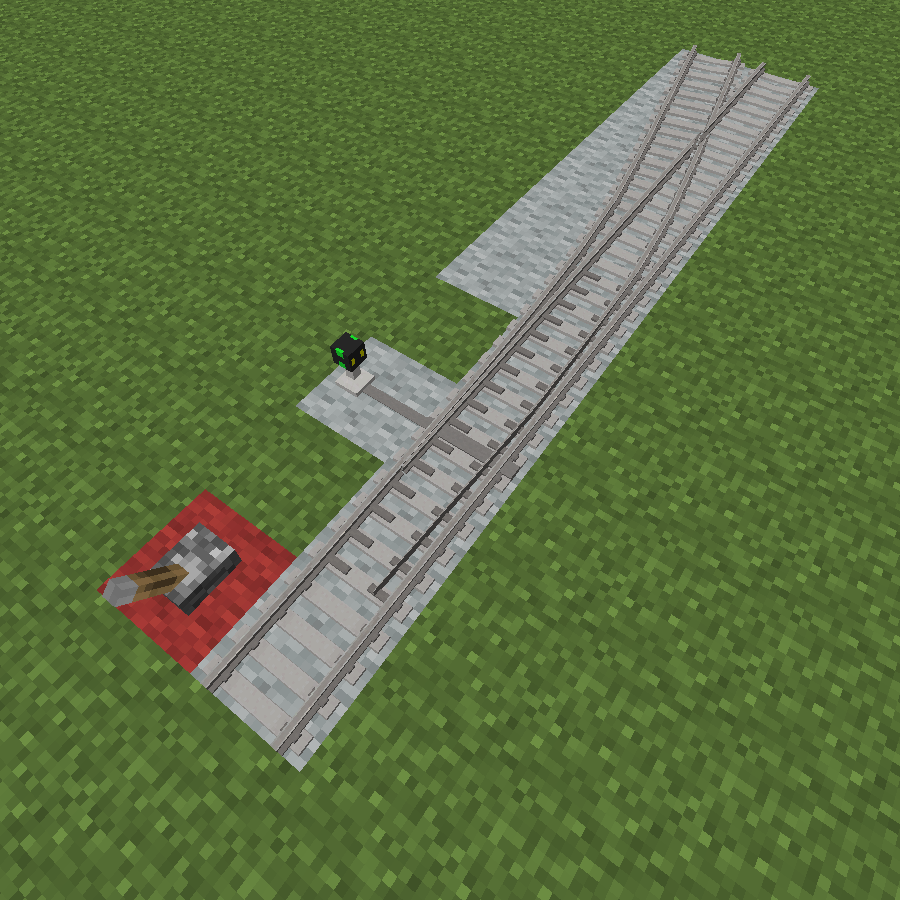
The Maintenance Track requires Stilts instead of Track Beds for construction. This track is 1 metre (= 1 block) above ground level and can be used to view a vehicle from below. Maintenance Tracks are also an essential part of the process of train creation. Right-clicking
the Maintenance Track with a crowbar hides its stilt.
Switch Tracks
To move a switch by Redstone state, remove the switching lever with the crowbar (rightclick) and apply the pulse to the origin (=source track) of the switch (see image on the right). Applying a redstone pulse to the switch changes the path it is set to.
Driving, placing & creating Trains
Train Controls
This page contains all default train controls. They can be changed in the mod configuration, which you can access from within Minecraft's title screen by pressing on Mods and selecting Zora no Densha in the list on the left side. Once selected, press Config and enter Cab Controls.
Default Keys:
Driving:
| Key | Effect |
|---|---|
| W | Move reverser forward |
| S | Move reverser backward |
| A | Increase throttle |
| D | Decrease throttle |
| " / Ä | Increase break force |
| { / Ü | Decrease break force |
| F | Enable/disable AFB (Cruise Control) |
| R | Increase AFB speed limit |
| V | Decrease AFB speed limit |
Train Configuration:
| Key | Effect |
|---|---|
| H | External light switch (4 Modes: Off/Shunt/Rear/Front) |
| J | High Beams toggle (needs light mode: Front) |
| K | Toggle cab lights |
| L | Toggle train lights |
| 9 | Turn MTCS screen on/off (centre screen) |
| 0 | Turn MTIS screen on/off (right screen) |
| I | Unlock/Close left Doors |
| O | Unlock/Close right Doors |
| P | Decouple cab coupler (Only with Scharfenberg coupler) |
| 7 | Raise/lower back pantographs |
| 8 | Raise/lower front pantographs |
Safety:
| Key | Effect |
|---|---|
| Q | Dead Man's Switch key |
| Enter | Emergency brake |
| Space | Horn |
| 9 | Turn MTCS screen on/ off |
| 0 | Turn MTIS screen on/ off |
Destination Displays
Some vehicles have destination boards installed. These are small screens which display the destination your train is heading to. You can set the destination which should be displayed using /setdest <Line1>, <Line2>.
Usually, <Line1> is your train number or line number with destination name, and <Line2> is either a list of via's (i.e. stations the train visits) or other information.
Porting Trains (from v0.9.X to v0.10.X)
The new ZnD-Version (v0.10.X) sadly has the side effect that most locomotives/EMUs/DMUs made in v0.9.X are not capable of driving on their own, when placed on a track. To better understand this guide, you can read this article about the model editor.
To make them drive again, you’ll have to edit the model from the old version and make a few modifications:
- Add Compressor Part:
v0.10 introduces a new (air) breaking system because of which ever locomotive hast to have a compressor. Just add it and move it to an offset position inside the trains body. - Connect bogies with the engine:
Click on every bogie and change the value of the setting “Has Engine?” from false to true. - Correct Tractive Effort:
While in the bogies, change the value of the setting “Tractive Effort” to the desired (higher) value.
Tractive effort must NOT be 0! - (Optional) Turn off Hitboxes:
If the train still won’t drive you may have to turn off some hitboxes of parts near the track/ground. To turn off a Hitbox click on the part and look for the setting “hitbox?”. Then change its value from true to false.
If you followed this guide completely, your train should drive normally again.
The Model Editor/Creating Custom Models
Zora no Densha adds the ability to assemble and configure a rail vehicle from a set of installed parts. Assembly of rail vehicles happens in the Engineer's Table.
Opening the Model Editor
Place an Engineer's Table and right-click it to open its GUI. In the GUI, select the Trains tab by clicking onto the center icon on the top right (the icon that shows the blue locomotive and the white passenger car). The GUI will change appearance.
GUI Elements
| Position | Element | Short Description |
|---|---|---|
| Top-left corner | Model Editor Window | View the vehicle you're editing, interact with it inside the window using your mouse/ touchpad. |
| Center-right | Vehicle parts and saved Presets | Add and (de-)select vehicle parts or load and export Preset files. Scroll through all pages by clicking the + and - buttons above. |
| Center-left, below Model Editor Window |
Input slots |
Input slots for Black Dye and Paper. These slots have to be filled in order for a Blueprint to be printed. |
|
Bottom-left (if selection isn't empty) |
Selection and Pivot data |
View and change the average data of the selection's elements, such as average offset and rotation. Set the Pivot's position. |
|
Bottom-right (if selection isn't empty) |
Selection index data |
View and change an individual part's data, such as offset, scale, rotation or color. Some parts might have additional fields that can be changed. Scroll through the selection's indices by clicking the + and - right next to the index number. |
Keyboard Shortcuts
Please note that following keyboard shortcuts assume that you use default settings; the respective key might differ depending on your settings.
| Key/Shortcut | Function | Short Description |
|---|---|---|
| CTRL+C | COPY selection | Copy the selection into the clipboard. |
| CTRL+V | PASTE selection | Paste the clipboard. |
| CTRL+Z | UNDO action | Undo your previous action. |
| G | MOVE selection | Grab and move the selection using your mouse. While grabbing, press X, Y or Z to move along a specific axis. |
| R | ROTATE selection | Rotate the selection along the view axis using your mouse. While rotating, press X, Y or Z to rotate about a specific axis. Change the Transformation Mode to rotate about local origin, selection center, or pivot point. |
| S | SCALE selection | Scale the selection in all dimensions using your mouse. While scaling, press X, Y or Z to scale along a specific axis. |
| X | DELETE selection | Remove the selection from the Model Editor. |
| 5 | Toggle orthographic/ perspective view |
Press to switch between orthographic and perspective view mode. |
|
8 |
Set camera angle - View along +X |
View the model's rear. |
| 2 |
Set camera angle - View along -X |
View the model's front. |
| 3 |
Set camera angle - View along +Y |
View the model's bottom. |
| 9 |
Set camera angle |
View the model's top. |
| 6 |
Set camera angle |
View the model's left side. |
| 4 |
Set camera angle - View along -Z |
View the model's right side. |
Model Editor Options (Drag down menu)
Right-click in Model Editor Window to open.
| Option | Short Description |
| Clear model | Remove all vehicle parts. Leaves the entire Model Editor window blank. |
| Save as Preset | Save the model as Preset file. |
| Toggle floor grid | Click to (de-)activate the floor grid displayed in the Model Editor window. |
| Transformation mode | Click to switch transformation mode (applies to rotation). Switches between individual origins, selection center, and pivot point. |
|
Orthographic/ Perspective view |
Click to toggle orthographic/ perspective view. Will change the camera's projection mode. |
| Toggle pivot | Toggles the pivot's size. |
| View in world | Click to toggle rendering in a small scene. Disables pivot and floor grid. |
| Set initial mass | Click to set a value to either increase your trains mass (positive value) or reduce its mass (negative value) |
Vehicle Part Options (Drag down menu)
Right-click on any vehicle part icon on the center-right of the Model Editor to open.
| Option | Short Description |
| Add to model | Adds the selected part to the model's center with default settings. |
| Deselect all | Removes all vehicle parts of the selected type from the selection. |
| Select all | Clears the selection, then adds all vehicle parts of the selected type to the selection. |
Preset Options (Drag down menu)
Right-click on any Preset icon on the center-right of the Model Editor to open.
| Option | Short Description |
| Load Preset |
Load the selected Preset. If there is another model in the Model Editor, it will ask to save. Clicking "No" will directly load the model without saving, clicking "Yes" will open the Preset save prompt. Press ESCAPE on your keyboard to cancel. |
| Prints the selected Preset as Blueprint. Requires the input slots to be filled. | |
|
Export as file (If not exported) |
Creates a Preset file in your Add-Ons directory. Use that file to share your Preset. |
|
Remove Preset (If not exported) |
Deletes the Preset forever. This cannot be undone! |
|
Remove from Add-Ons (If exported) |
Deletes the Preset from your Add-Ons directory forever. This cannot be undone! |
|
Move to begin (If not exported) |
Moves the Preset to the first index of Presets. The first index will be rendered on top of the Engineer's Table. |
Assembling and editing vehicles
In the Model Editor, either load a Preset and edit it or start off with a clear model. Add Vehicle Parts and customise them to your taste. Once you are finished, save your glorious work as a Preset.
Printing vehicles
Right-click a Preset in the Engineer's Table GUI to print it. Remember to fill both input slots with Black Dye and Paper.
Blueprints have infinite uses. Right-click with a Blueprint in the center of a Maintenance Track section that is at least as long as the vehicle you're going to create. If the vehicle doesn't spawn, the track might be too short, or there might be blocks or other things obstructing the vehicle.
If the vehicle was successfully spawned, a transparent "ghost" model will be shown. (Please note: This will spawn the vehicle instantly, if instant-spawning in creative mode is enabled.) To finish the vehicle, apply Vehicle Part items to all ghost parts, until all parts appear. If you decide not to finish a vehicle, simply whack it and it'll drop all applied parts. Once you are sure that you've applied all parts, hit the vehicle to drop it as item. If you haven't forgotten to apply any parts, the vehicle will properly drop as item, if the respective setting was enabled in your mod's configuration. You can use the finished vehicle immediately.
Exporting and importing Preset files
Export a Preset by right-clicking it in the Model Editor and selecting "Export as file". A file will automatically be created inside of your Zora no Densha/ directory. You can copy this file and share it with whomever you like.
Import a Preset by dropping a Preset file in your Zora no Densha/Add-Ons/ directory. After you restarted your game, the new file will be shown in the Model Editor.
Magnets, Paths & Signals
Here you can learn everything about the built in signaling system!
Configuring Magnets
Magnets are the core component of ZnDs MTCS system (similar to ETCS). MTCS is a system made for controlling trains and using autodrive.
Placing magnets:
Magnets can be placed on these tracks:
Configuring magnets:
Linking Signals to Magnets
Signals do not have any effect on your train if they are not linked to a track magnet.
To link a signal to a track magnet you once again need your Signaller's Tool.
Creating Paths
Paths are used to tell trains where to go. If an autodriving train is configured with a path it tries to follow this path until there is no more path of this name found in the next signal.
Preparation:
Make sure that all of your switches are put in the right position for the path you are configuring. This cannot be changed after the track is selected with your Signaller's Tool.
Creating a Path:
Selecting a Path:
Simply type /setdest {insert path name}in the chat. The MTMS-Display should then display upcoming speed limits and your train (if autodrive is turned on) should begin driving.
Types of Signals
Whether you are building a high speed train, tram line or regional service, signals are on of the essentials which everyone of these needs.
Since ZnD v0.9.1 ZnD has its own signals built in, but since v0.10. you can expand these standard signals with signalpacks.
Settings:
Signal Settings:
These settings are common among all signals, even signals from signalpacks.
Values: 0 = "off", 1 = "on"
| Name: | Function: | Default |
| Post Offset L/R | Offsets a signal to the left or right. -1 = offset to the left, 0 = centered on base, 1 = offset to the right |
1 |
| Load Chunks | Loads chunks which a selected path crosses | 0 |
| Redstone Mode | Control the signal with redstone | 0 |
| One Way | Trains can pass the signal only in one direction | 0 |
Path Settings:
Values: 0 = "off", 1 = "on"
| Name: | Function: | Default |
| Big Black Box | Path name | -- |
| Default |
Sets Path as the signals default path |
-- |
| Shunting |
Lets a train pass the signal even if |
-- |
| Speed | Sets the Paths vMax | 40/-- |
| Route |
Sets the paths nickname |
-- |
| Duplicate | Duplicates a path and all of its settings (apart from "Deafult") | -------------------------------------------------------------------------------------------- |
| Delete | Deletes a path from the signal. This CANNOT be undone! |
-------------------------------------------------------------------------------------------- |
Default Signals:
- Block Signal
- Distant Signal
- Tunnel Signal
- Dwarf Signal
- Tram Signal:
Good to know:
Tram Signal:
Setting the Route Setting to L or R Displays a \ or / instead of | when the path is selected:
L = \,
-- = |
R = /
Default Signs:
- Speed Limit Sign
- MTCS Flag Signal
Signal Aspects
This is an overview of how the default signalling system that comes with Zora no Densha works.
Signalpacks
Signalpacks are a way to integrate more signals of different countries into ZnD.
List of Currently Available Packs
Signalpacks:
How to Install Signalpacks:
To be able to install and use a Signalpack, you need to install the ZnD basemod first.
- Download the Signalpacks .jar file from its Wiki-Page
- Open your Minecraft mods folder
- Copy the Signalpacks .jar file into your mods folder
German Signals
Types of Signals:
Electronic Signals:
- Ks Main Signal
- Ks Distant Signal
- Ks Block Signal
- Ks Tunnel Signal
- H/V Main Signal
- H/V Combined Signal
- H/V Distant Signal
- Hl Main Signal
- Hl Distant Signal
- Dwarf Signal
- LZB Virtual Signal
Settings:
Values: 0 = "off", 1 = "on"
| Name: | Function: | Default: |
| (Upper) Speed Indicator (Zs 3) | Adds/Removes a dedicated speed indicator | 0 |
| (Lower) Speed Indicator (Zs 3v) | Adds/Removes a dedicated speed indicator | 0 |
| Route Indicator (Zs 2) | Adds/Removes a dedicated path indicator - displays selected paths name | 0 |
Mechanical Signals:
- H/V Main Signal (Old)
- H/V Combined Signal (Old)
- H/V Distant Signal (Old)
Settings:
Values: 0 = "off", 1 = "on"
| Name: | Function: | Default: |
| (Main) Lower Arm (Hp 2) | Adds/Removes a lower mechanical arm | 0 |
| (Distant) Lower Arm (Vr 2) | Adds/Removesa lower mechanical arm | 0 |
Types of Signs:
Speed Signs:
- Speed Sign (Lf7) - displays new speed limits
- Speed Sign (Lf6) - displays upcoming speed limits
Version History:
Version 1.3:
- Added mechanical H/V Signals
Version 1.1:
- Created Ks Signals
Items, Fluids, etc.
List of Items
C
|
Circuit |
|
|---|---|
| Used as crafting ingredient. |
|
Coal Coke |
|
|---|---|
| Coal Coke is retrieved from the Coke Oven by smelting Coal. It can be used as fuel and crafted into a Block of Coal Coke. |
|
Crowbar |
|
|---|---|
| Used to remove items from Signs, Crossing Posts, and to safely disassemble a track. |
D
|
Driver's Key |
|
|---|---|
| Used to access various structures, such as Level Crossing Boxes. Also used to unlock trains. |
F
M
|
Machine Kit |
|
|---|---|
| Used during construction of multi-block structures, such as the Refinery or Retorter. |
|
Monitor |
|
|---|---|
| Used as crafting ingredient. |
O
|
Oil Shale |
|
|---|---|
| Processed in the Retorter to obtain Crude Shale Oil. Retrieved by mining Oil Shale Deposit blocks. |
P
|
Plastic Dust |
|
|---|---|
| Used as crafting ingredient. Smelted from Tar Blocks in the furnace. |
|
Plastic Casing |
|
|---|---|
| Used as crafting ingredient. |
|
Plastic Sheet |
|
|---|---|
| Used as crafting ingredient. |
R
|
Rails |
|
|---|---|
| Used to for track assembly. Can also be placed in the world. |
|
Reflective Jacket |
|
|---|---|
| A wearable jacket with a fancy look. Inspired by the Dutch NS conductor's jackets. |
|
Reflective Vest |
|
|---|---|
| A wearable vest with a bright look. |
S
|
Steel Ingot |
|
|---|---|
| Used as crafting ingredient. Smelted from Iron Ingot in a Blast Furnace, or crafted from 9 Steel Nugget. |
|
Steel Nugget |
|
|---|---|
| Used as crafting ingredient. Crafted from a Steel Ingot. |
|
Steel Plate |
|
|---|---|
| Used as crafting ingredient. |
|
Stilts |
|
|---|---|
| Used instead of track beds to assemble a Maintenance Track. |
T
|
Track Bed |
|
|---|---|
| Used to for track assembly. Can also be placed in the world. |
|
Track Bed (Concrete) |
|
|---|---|
| Used to for track assembly. Can also be placed in the world. |
|
Track Plate |
|
|---|---|
| Can be used when assembling straight tracks. When applied, a track will render plates on top of itself. |
|
Railway Worker's Tool |
|
|---|---|
| Used configure infrastructure and to copy tracks in Creative Mode. |
W
List of Liquids
This page contains a list of all liquids added by Zora no Densha.
It will be updated according to development, thus there may be features listed that are not available yet.
C
|
Creosote Oil |
|
|---|---|
 |
Used to craft Wooden Track Bed and as fuel in a furnace. Each bottle/ bucket lasts twice as long as wood. Ore Dictionary Name: oilCreosote Density Value: 1070 Temperature Value: 400 |
|
Crude Bio Oil |
|
|---|---|
 |
Processed in the Refinery to retrieve refined products, such as fuel. Ore Dictionary Name: oilBioCrude Density Value: 1250 Temperature Value: 293 Viscosity Value: 2300 |
|
Crude Shale Oil |
|
|---|---|
 |
Processed in the Refinery to retrieve refined products, such as fuel. Ore Dictionary Name: oilShaleCrude Density Value: 992 Temperature Value: 288 Viscosity Value: 2400 |
D
M
|
Machine Lubricant |
|
|---|---|
 |
Used for vehicles and buffer crafting. Ore Dictionary Name: oilLubricant Density Value: 950 Temperature Value: 288 Viscosity Value: 7500 |
|
Machine Oil |
|
|---|---|
 |
Used for vehicles and bogie crafting. Ore Dictionary Name: oilMachinery Density Value: 910 Temperature Value: 288 Viscosity Value: 900 |








